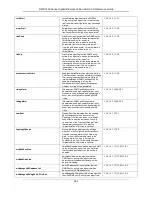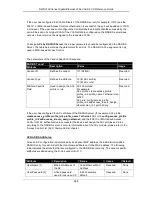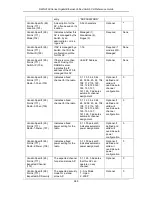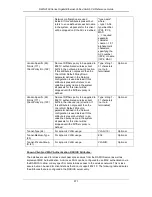
DWS-3160 Series Gigabit Ethernet Unified Switch CLI Reference Guide
975
Appendix F
Wireless Switch Specific
Authenticated Roaming and Clustering:
Captive Portal Guidlines
In addition to the generic implementation, Captive Portal also provides two key features for the
wireless networks called
authenticated roaming
and
clustering
.
1. Authenticated roaming allows the client to roam from access point to access point in a
seamless fashion while remaining authenticated.
2. Clustering provides roaming between access points attached to different switches and
monitoring Captive Portal status for all switches from the Cluster Controller.
The Switches in the cluster must share the same Captive Portal settings, such as Captive Portal
Configuration instances, associated interfaces, local user database and RADIUS server settings.
The databases should be synchronized in a cluster to support client authenticated roaming.
Each Switch in the peer group makes an independent decision about who is the Cluster Controller.
If a Switch does not have any peer Switches, then it appoints itself the Cluster Controller.
Cluster Controller Election
When two Switches detect each other through the discovery process, they compare the value of
the Cluster priority field. The Switch with higher priority becomes the Cluster Controller. If the
priority is the same, then the Switch with lower IP address becomes the Cluster Controller. The
Cluster priority is conveyed in the initial identification message
The Cluster priority has a range from 0 to 255. Setting the priority to 0, disables the Cluster
Controller function on the Switch. Customers may want to disable the low-end Switches from
becoming the Cluster Controller if they deploy a large network where only a high end switch or
network appliance is powerful enough to act as the Cluster Controller.
The administrator may change the Switch Cluster priority value after the Switch has already joined
the peer group. The Cluster priority is also conveyed in the keep-alive message enabling the peer
Switches to learn the new Cluster priority of the Switch.
A Switch performs the election process after it boots, after it loses connection to the current
Cluster Controller, and every time it receives an initial identification message or a keep-alive
message from another Switch. The Switch keeps a list of Cluster priorities and IP addresses for
each peer Switch and elects the Cluster Controller based on the criteria described above.
If a Cluster Controller Switch decides that it is no longer a controller because it receives a
message from another Switch with higher Cluster priority or lower IP address, then it purges some
of the databases.





































